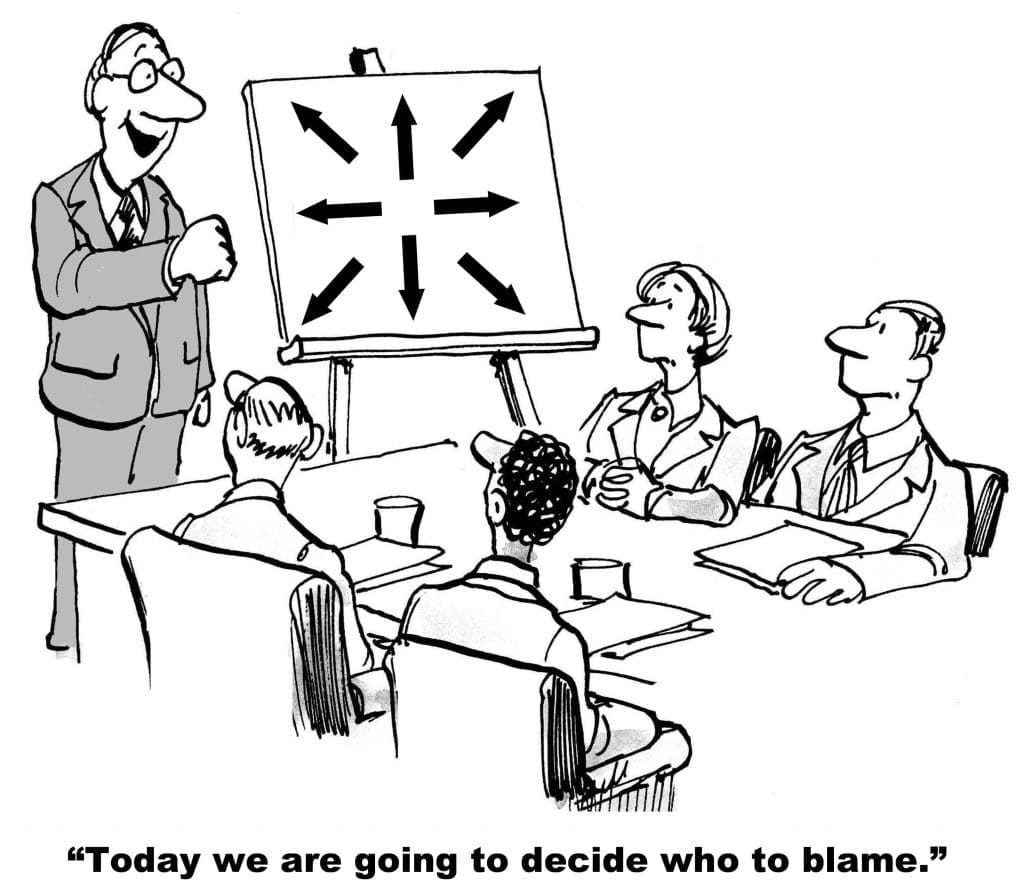Sadly, more and more these days it seems that there’s an epidemic of business leaders refusing to take responsibility for their or their company’s actions, passing the buck to whomever they can: employees, the press, a computer glitch, the global economic turnaround…the list goes on.
What has happened to corporate integrity? To the notion of “the buck stops here”?
As a corporate anthropologist, I believe the problem clearly lies in a dysfunctional culture. Every company has its own individual culture, a set of habits, rules and morés—sometimes openly communicated, sometimes unspoken—that govern how employees interact and get along. When this culture is faulty, as we are seeing so often these days, employees can easily lost their way.
Our guest blogger, Cheryl McMillan, CEO Coach with Vistage International, has written an excellent and very timely blog on the subject, which I share here. Enjoy.
_______________________________________________
It’s Not My Fault!
“People are always blaming their circumstances for what they are. I don’t believe in circumstances. ~ George Bernard Shaw
I was driving to a member’s office when I noticed a bumper sticker on the truck in front of me that said “Don’t move firewood, it bugs me.” Even though the meaning of the bumper sticker was a pun that moving firewood spreads unwanted pests, it struck me as a good metaphor for irrational blame. That is, my only problem is you or what you are doing and if you would change, I would be fine. In other words, it is easier to blame others than to look for our own contribution to our problem.
Psychology Today stated that there are four erroneous beliefs involved with irrational blame and unreasonably acting like a victim:
- If something has gone wrong, then someone other than myself must be identified and blamed for causing the situation.
- This person’s wrong-doing justifies the amount of disrespect he/she deserves. Blaming objectifies the other person.
- So, it is permissible (and only fitting!) to treat this person in ways that he/she deserves to be treated (such as being fired).
- I must not accept any significant degree of responsibility for the situation, because to do so would be to admit that I am myself also diminished as a person, and therefore deserving of the same condemnation and negative treatment.
Some recent statements by CEO’s of prominent companies illustrate these beliefs by transferring their responsibility to “villainous” employees.
The Wall Street Journal wrote about Wells Fargo fraudulent customer sales:
As public and congressional pressure mounted on Wells Fargo & Co. executives, its top two bankers had an explanation Tuesday for allegedly illegal sales practices across the company: It was employees’ fault.
In an interview with CNBC, Wells Fargo CEO Stumpf said (about customers receiving a product they didn’t order): “…there is nothing in our culture, nothing in our vision and values that would support that.” In addition, he denied that he blamed employees in the above WSJ article.
Last year, Michael Horn, VW’s U.S. CEO blamed rogue engineers for writing fraudulent emissions software when he said, “To my understanding, this was not a corporate decision. This was something individuals did.“
Common sense tells us that given the scale and complexity of these fraudulent behaviors, the top Executives of these companies had to know something. If their statements weren’t so egregious, they would be amusing. But, for these unaware and immature leaders, the human urge to place blame on something external when the real issue is them, was too tempting.
How to Stop Blaming
Blaming others indicates a lack of ability to accept and cope with difficult situations. Employees and customers rely on great leadership in times of crisis and failure. In these times, it is the duty of CEO’s and Executives to accept responsibility for results.
Here are some steps to avoid the blame game and demonstrate maturity.
1. Recognize the temptation to blame. It is a red flag that you are blaming if you find yourself thinking or saying any of these:
- Why are you being difficult?
- If you would change, I would feel better!
- If the situation was different, I would be fine!
- It’s your fault.
2. Take responsibility. It takes guts and courage to take responsibility for your own actions related to a failure. Before you discuss it with anyone else, take some time to reflect. Ask yourself how you contributed to this situation, especially when doing so is damaging or embarrassing. This question sheds light on why you are not a victim.
3. Be more empathetic. Look at the situation from the other person’s perspective. If you were raised like he/she or had their life experiences, how would you feel or react?
4. Focus on a solution. Blaming moves your focus from you to others or to circumstances. When you blame, you also tend to only look externally for a solution. Shift your focus to being a part of the solution.
5. Learn and make improvements. Use this as a learning opportunity rather than spending time and energy looking for scapegoats. Look at the processes, understand where they failed, and then change them so that the issue does not recur.
6. Eliminate fear and punishments.
Ban blame and fear-inducing behavior when something goes wrong in your organization.
Employees need a safe environment that supports complete honesty. Otherwise, employees fear being blamed and are naturally dis-incentivized to be honest and to accept responsibility.
When a mistake is made, ask your employees how it happened instead of who is responsible.
In the short run, it may be easier to avoid responsibility by blaming others or circumstances, but that is NOT leadership. The best leaders say, “The buck stops here. I’m responsible.”
As a Master Chair for Vistage in NE Ohio, Cheryl leads 4 local peer advisory boards, comprised of CEO’s and Senior Executives from non-competing companies. She is also a Certified Enneagram Teacher in the Narrative Traditionand blogs regularly at CherylMcMillan.com.



